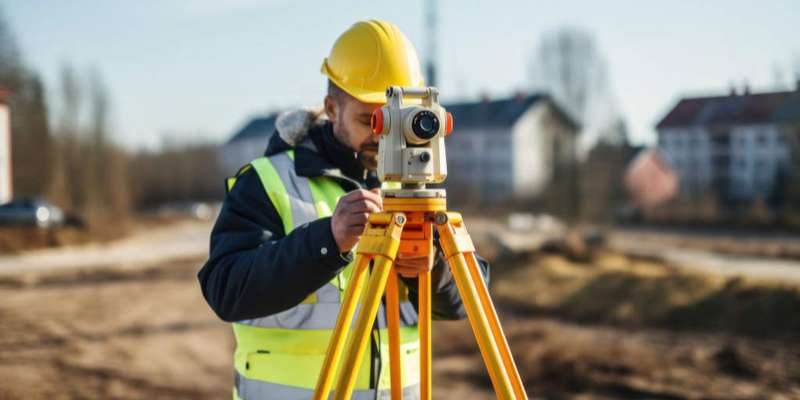What Is a Land Survey?

Buying a property, planning a build, or attempting to settle a boundary question? The success of these scenarios depends on one very important factor: knowing exactly where your property and rights begin and end - and that’s where land surveys become part of the process.
Far from just simple maps and measurements, land surveying provides the groundwork for property ownership and development.
In layman's terms, land surveying is the process of defining property boundaries, identifying encroachments, and highlighting easements and right of ways, all of which are essential to help avoid disputes and additional cost burdens. The process of buying, selling, or building usually (but not always) requires land surveying to ensure you have the precise information to make a sensible decision based on facts.
Through this guide, we will cover what land surveying is - and why it is so important - before discussing the different types of land surveying used for residential, commercial, and municipal projects.
Let's start with the basics. What is a land survey, exactly?
What Is a Land Survey?
Land surveying is a comprehensive examination of a property’s physical features and legal boundaries. This process measures and maps out the dimensions of a parcel, providing an accurate understanding of its layout. Conducted by professional surveyors using specialized equipment, land surveys help clarify ownership limits and provide a foundation for legal property records.
Again, one important aspect of land surveying is identifying property boundaries. In an ideal world, this should prevent neighbours from encroaching on each other’s land, whether intentionally or by accident. Land surveys also pinpoint right of ways, and easements (areas where utilities or other services might have access) and highlight encroachments, such as a neighbour’s shed or fence crossing the boundary line.
Land surveying is crucial in a broad range of scenarios, from buying a small starter home to launching a vast construction project spread over hundreds of acres. Without land surveying, property disputes, legal challenges, and sometimes extremely costly errors can arise. To that end, describing a professional survey as merely ‘important’ in terms of astute property management might be something of an understatement - they are an absolute prerequisite.

Types of Land Surveys
As you might imagine, land surveys take various forms depending on the context. Familiarising yourself with them will help you to determine the most suitable survey for the project in question. Let’s take a look.
What Is a Property Line Survey?
A property boundary survey defines the exact limits of a parcel of land. This type of survey is often required when you build a fence, to ensure it is constructed on the property line. It ensures the boundaries in the legal descriptions match the physical layout. It also identifies any encroachments, such as fences or structures, that cross into neighbouring properties.
What Is a Real Property Report?
The RPR or Real Property Report is the most popular type of survey done, as it is the one used for real estate transactions. For this work the Surveyor will produce a plan or map showing the parcel, all the right of ways and structures on it, and it will be evaluated by the municipality for by law violations.
What Is a Site Survey?
When planning a construction project, a site survey focuses on the specific area marked for development. It captures essential information about the land's dimensions, along with identifying critical features that could affect construction – from existing utility lines to neighbouring structures. Builders rely on this type of land surveying to verify that their site plans are both accurate and practically achievable.
What Are Topographical Surveys?
As the name implies, topographical surveys map a property's natural and man-made features, including elevations, slopes, trees, and buildings. These land surveys are especially helpful for architects and engineers designing structures that must naturally integrate with the land’s contours and overall look and feel.
What Are Subdivision Surveys?
Subdivision surveys are a necessary form of land surveying when dividing a larger parcel of land into smaller lots. More common in residential developments, land surveying in this particular niche creates new titles and parcels of land for legal documentation. Because these plans are approved by the municipality it also ensures strict compliance with local zoning and development regulations.
Each type of survey is incredibly important to the project in question, but why is land surveying so critical, exactly? In the next section, we will elaborate and demonstrate why land surveying is so significant.
Why Land Surveys Are Important
Land surveying is crucial in protecting private property ownership and ensuring or encouraging the success of development projects. It provides the relevant, accurate information needed to prevent potential disputes, adhere to strict legal requirements, and avoid costly errors.
In property transactions, surveys confirm the exact boundaries of the land being bought or sold. This helps both buyers and sellers avoid misunderstandings and ensures the property lines match what is stated in legal documents. Without this step, transactions can easily lead to disputes or financial losses.
Construction projects also depend heavily on surveys. Builders and developers use them to determine site dimensions, elevation changes, and other key features that affect project design and execution. Thorough and detailed land surveying ensures that plans meet with the actual reality on the ground, so to speak.
Land surveying is equally vital for resolving common boundary disputes. By clearly marking property lines, helping neighbours settle disagreements and greatly reduce the potential for ongoing conflict.
In each instance, land surveying delivers the clarity and precision needed for well-informed decisions based on fact.
The Land Surveying Process

Land surveying involves a diligent, systematic process. Using legal principles, scientific understanding of the shape of the earth, total stations GNSS (GPS) and other advanced tools like drones and 3d scanners to produce highly accurate plans.
The process begins with fieldwork, where surveyors visit the site to gather data. Using state-of-the-art tools like advanced GPS devices, total stations, they map out the property’s physical boundaries and note any features such as buildings, fences, or utility lines. This on-site work forms the foundation for the survey.
Next comes data processing, where those initial field measurements are carefully analyzed and calculated into CAD where this information is used to create detailed maps and reports that depict and demonstrate the property’s dimensions and features. Again, these documents are absolutely essential for legal, construction, or planning purposes.
The final step is presentation, where the surveyor delivers a completed report (such as a property survey or site survey) to the client. This step includes making the data presentable and readable to all the stakeholders, as well as adding information from the title into the title block as well as other important information and technical details. This report provides clear, actionable information, ensuring the landowner or project manager has a reliable basis for decisions. Usually this is delivered as a PDF file, but if the project involves designers, the CAD files are also provided.
When Should You Get a Land Survey?
Ultimately, knowing when to commission a land survey can save you a great deal of time, money, and possible drama.
- Land surveying is essential during most real estate transactions, whether you are buying, selling, or refinancing. The RPR (Real Property Report) confirms that the property boundaries match legal descriptions and highlights potential issues, such as encroachments, right of ways, and easements.
- A survey is crucial for construction projects before breaking ground. Site surveys ensure the planned work will fit the land's physical features and comply with zoning regulations. Without this step, costly adjustments or delays could, and probably will, arise at some point.
- Even long-term property owners might benefit from land surveying, especially when installing fences, driveways, or other improvements near boundary lines. A professional land survey helps avoid inadvertently infringing on neighbouring land.
A survey provides impartial, documented evidence to resolve disagreements over property lines. Either way, knowing your land's exact dimensions can prove invaluable in terms of addressing conflicts or planning future projects.
What Is a Land Survey? Bottom Line
Land surveys are an essential tool for transparency, clarity and confidence in property ownership and development. In short, they provide accurate measurements and detailed reports to help prevent disputes, guide construction projects, and ensure strict compliance with relevant legal standards.
Land Survey FAQs
How accurate are land surveys?
The accuracy of a survey depends on the methods and tools used. Professional land surveying ensures precise measurements for property boundaries and features.
How much does a survey cost?
Costs vary based on the survey type and property size. Whether you need a property survey or a site survey, consulting a surveyor provides clarity on pricing and scope.
Why are surveys necessary?
From confirming boundaries to resolving disputes, surveys like what is a land survey provide essential data for property decisions.
HWhen should I get a land survey?
A survey is recommended during property transactions, before construction projects, or when resolving boundary disputes. Understanding what a land survey is ensures you're prepared for these scenarios.
HDo I need a survey for an existing property?
For established properties, a survey can confirm accurate boundaries and highlight any changes over time. You would want to do this if you were doing construction work, or planning to sell the parcel.
HDo I need a survey if the property already has a fence?
Yes, having a fence does not guarantee that it aligns with the legal property boundaries. A land survey ensures the fence is placed correctly and identifies any encroachments or discrepancies with neighbouring properties.
HHow long does a land survey take?
The time required depends on factors like the property’s size, terrain, and complexity. But most take between ½ and a full day in the field. It takes about the same amount of time in the office as the field to do the calculations, drafting and quality assurance.